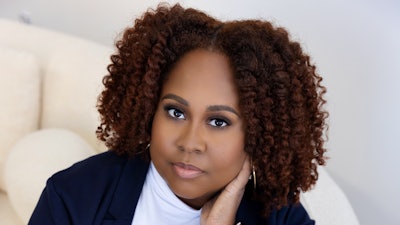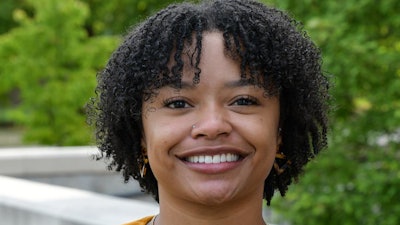As a Black woman who studies the educational experiences of Black women and girls, Dr. Tiffany Steele says she always felt like her work was never quite valued.
“If you focus on minoritized populations, there’s a lack of understanding about why this research is relevant,” she says.
Editors of top-tier journals couldn’t comprehend why she chose to focus on Black women instead of Black people generally, and if she wanted to talk about Black women and girls in the courses that she taught, she had to figure out how to slip the material into the pre-designed curriculum. She was even told that she focused too much on race in a class about diversity.
The experience was isolating. Steele describes going to conferences with few sessions centering on Black women and having trouble finding mentors.
“We have to find those pockets of other researchers who are doing this work and creating spaces for ourselves,” she says.
But all of that changed in 2022, when Steele saw a listing for a job at the University of Rochester’s Warner School of Education and Human Development. Rochester was looking to hire faculty whose work focused on diversity, equity, inclusion, and justice. And they weren’t looking to just hire one. They were hiring three.
Rochester was engaging in a cluster hire, the technique of simultaneously bringing on several faculty members with similar backgrounds or research interests in the hopes that they can work together and, if all goes well, create a sense of belonging. Cluster hiring instantly injects diversity into departments that have little, while making the experience easier for minoritized faculty members. Because several minoritized professors are being hired at once, they are less likely to be tokenized and burdened with extra diversity, equity, and inclusion work. And by providing support, mentoring, and a ready-made network of peers, clusters can help minoritized faculty avoid burnout and stay in their roles.
A diversity strategy
It’s an important method to diversify a professoriate that remains stubbornly white. And an increasingly popular one. Since the racial reckoning of 2020, sparked by the murder of George Floyd at the hands of a Minnesota police officer, many institutions have announced cluster hires of either minoritized faculty or professors who study issues like race and justice. Among them are Harvard; Stanford; the University of Michigan; the University of California, Berkeley; and the University of North Carolina, Wilmington.
Cluster hires are also taking on increased significance as diversity, equity, and inclusion efforts come under attack nationwide.
“We’ve seen a rise in hate,” says Dr. Bridget Kelly, an associate professor and student affairs & diversity officer at the University of Maryland’s College of Education. “[Cluster hires are] a really interesting way to try to make departments and fields more equitable.”
For Steele, being part of a cluster hire made her experience at Rochester much easier.
“I didn’t feel like I was doing it by myself,” she says.
Steele was able to consult her cluster-mates for advice inside and outside of the classroom.
“We would meet and share ideas about different approaches that we would want to try in our classroom spaces. We shared a lot about different techniques we were considering that may not be traditional, such as un-grading,” says Steele. “It was also really important in making Rochester feel like a place where I actually live a life and not just work.”
 Dr. Candace N. Hall
Dr. Candace N. Hall
Hall says that her community of cluster-mates and others has been “the biggest thing that helped to sustain her” as she adjusted to her new role and environs during the COVID-19 pandemic. Hall began hosting bi-weekly bonfires in her backyard for her fellow new hires and other young faculty. Without these gatherings, “I don’t know if I would have survived the pandemic,” she says.
Hall was so enamored of her cluster that she produced a short film about it, documenting how the relationships that she and the other professors had formed helped them navigate being people of color in academia. Clusterluck won the Best Documentary Feature Over 20 Minutes award at the St. Louis Filmmakers Showcase and is scheduled to screen at the St. Louis International Film Festival in November.
Building community
Clusters can also support researchers of color when the academy doesn’t. Steele remembers being at an event for new faculty. An older white male asked her what she did at the university. After she told him, he said, “Hmmm… the school has definitely changed.” Steele was offended, but she wasn’t sure if she was being overly sensitive.
“As a Black woman, I want to have a heart-to-heart about certain things. I had to go to one of my cluster hire mates,” she says. “It was an affirmation that you’re not crazy, you’re not making things up, you’re not blowing it out of proportion. It just made me feel OK.”
Hall has had similar experiences and received similar support. One time, she was teaching an evening class, and a white custodian asked why she was in the building. Another time, a white staff member tried to kick her out of a room because a meeting was going to be held there. Hall had been invited to the meeting.
“It’s definitely helpful to hop on the group chat and process or go eat lunch together,” says Hall. “Just being able to say what you’re feeling out loud and to be heard and to be validated is helpful.”
Of course, institutions can’t simply hire a group of minoritized faculty and expect them to flourish without any support.
“It has to be done with intentionality and care,” says Hall. “To simply pursue it because it’s on-trend is irresponsible. These are people’s lives and livelihoods.”
Hall says she has received good assistance from SIUE. She was paired with a mentor who, like her, was a Black mother who had transitioned from staff to a tenure track role. The administration also made sure that Hall wasn’t assigned an unreasonable amount of administrative or DEI work. “We can’t clone you, so we have to protect you,” they told her. Hall was encouraged to lean into who she is, to do, as she put it, the scholarship that feeds her soul.
 Dr. Tiffany Steele
Dr. Tiffany Steele
“I just wanted to get an understanding from Black women who have been here longer about if they felt like they were welcome, if they felt like they were valued, if they felt like this wasn’t a good idea for me,” says Steele.
Rochester met her request enthusiastically, making the connections immediately and even setting aside time during her interview schedule for Steele to meet with them. After she was hired, Rochester paid for Steele and the other new faculty to fly to the city to see the school in person and to meet with a realtor about finding a home in the area. To Steele, it showed that the school planned to be supportive of her while she was there.
Facing opposition
Not all factions are always so pleased when they hear that a school is making a cluster hire. Dr. Robin L. Hughes, dean of the SIUE School of Education, Health, and Human Behavior, who shepherded the cluster hire that included Hall, says she encountered all kinds of opposition. Hughes was told that she focused on diversity too much, that she was hiring people who weren’t qualified, and that she was hiring people because they were black. Her response to the last charge? “I absolutely am!”
That sort of objection is common, according to Kelly. She recommended that institutions make it clear that the expectations for the newly hired cluster faculty will be the same as for anyone else, to defend against that sort of criticism. She also says universities have an obligation to make sure that faculty are knowledgeable about systemic oppression, equity, and justice. Institutions or departments should have book clubs or colloquia about research on underrepresented minorities in the faculty, she says, and talk about what they are doing to bolster representation.
However, cluster hires may become more difficult to execute, especially ones that explicitly involve race, following the U.S. Supreme Court’s June ruling that race-conscious admissions practices are unconstitutional. Although Chief Justice John G. Roberts’ majority opinion does not discuss racial preferences in hiring, some may believe that they are implicitly included.
“People are pretty litigious lately, and search committees are in fear of doing something wrong,” says Kelly. “I would advise them to do it cautiously. I don’t think it could be based on race, given the climate that we’re in. You’d have to make it much more about what perspectives people are bringing as opposed to just because they’re a person of color.”
Hall says she was happy that cluster hiring seemed to be growing more popular. But she was concerned that it might not last.
“I hope that we don’t see the sort of rollback that I think we’re seeing with some of the commitments institutions made around the summer of 2020. Now we’re seeing institutions reel that in,” she says. “I hope that that’s not the same thing that happens with cluster hires.”
If universities back away from cluster hiring, they’ll still recruit minoritized faculty members. But retaining these faculty, like Steele, may become a tougher task.
Without her cluster-mates, “it would have been 10, 20 times harder,” Steele says. “It definitely helped me stay in the role.”





















